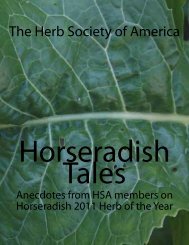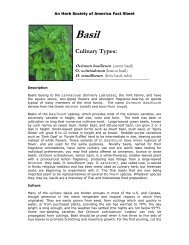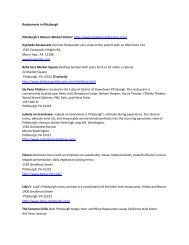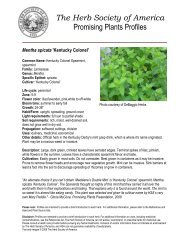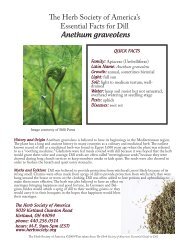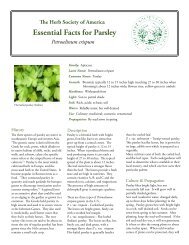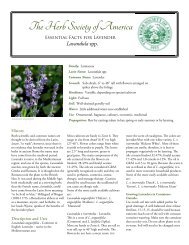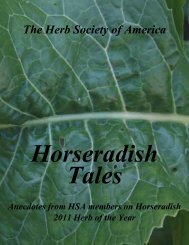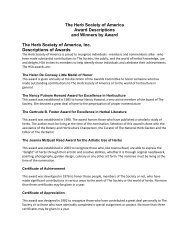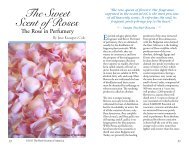WesternPA4-09herb thymes - The Herb Society of America
WesternPA4-09herb thymes - The Herb Society of America
WesternPA4-09herb thymes - The Herb Society of America
You also want an ePaper? Increase the reach of your titles
YUMPU automatically turns print PDFs into web optimized ePapers that Google loves.
HERB<br />
THYME<br />
S<br />
THE HERB SOCIETY OF AMERICA<br />
WESTERN PENNSYLVANIA UNIT<br />
Volume XXXVI Number 3 March, 2009<br />
Editor: Liz DePiero 412-341-8014 lizarddep@verizon.net<br />
CHAIR’S MESSAGE FOR APRIL<br />
It’s no joke ---spring is actually here, sneaking in late in March. But<br />
someone forgot to tell the weatherman to warm things up!<br />
And the April showers sneaked in early too. Not that we really cared,<br />
since we needed some rain. And we know what April showers will bring.<br />
On one <strong>of</strong> those few truly warm days nestled among all the cold, cold<br />
ones, I treated myself to a sunny luncheon on the patio. Not much was<br />
stirring. But a lone wasp settled on the concrete table beside me…searching<br />
for what Warmth Certainly not food there Maybe just to gather strength<br />
to move on after a long winter sleep. It provided an unusually long<br />
observation period in a comfortable setting – no alarm or fear. What<br />
gorgeous creatures nature holds, if only we have the opportunity to<br />
experience them.<br />
<strong>The</strong> garden visitors are just beginning to scurry around: robins,<br />
squirrels, and bunnies – yes bunnies. Just in time for our “Tea with Peter<br />
Rabbit” on April 6th. We welcomed in springtime with glorious sandwiches<br />
and cakes along with tasty teas. This activity was a lot <strong>of</strong> fun, and we added<br />
to our Scholarship Fund.<br />
<strong>The</strong> gentle rains reminded me <strong>of</strong> a little poem from childhood:<br />
Flower <strong>of</strong> the<br />
Month is<br />
daisy
<strong>The</strong> <strong>Herb</strong> <strong>Society</strong> <strong>of</strong> <strong>America</strong> is dedicated to promoting the knowledge, use and delight <strong>of</strong><br />
herbs through educational programs, research, and sharing the experience <strong>of</strong> its members<br />
with the community.<br />
<strong>The</strong> Western Pennsylvania Unit maintains public herb gardens at Mellon Park, in Shadyside,<br />
and at Old Economy Village, in Ambridge. Monthly meetings, with lunch, are usually held on<br />
third Mondays, at the Garden Center about half the time.<br />
HERB THYMES APRIL, 2009 PAGE 2<br />
RAIN<br />
<strong>The</strong> rain is raining all around,<br />
It falls on field and tree,<br />
It rains on the umbrellas here,<br />
And on the ships at sea.<br />
Robert Louis Stevenson<br />
And now the rains will really push things ahead. <strong>The</strong> Cornus mas is a<br />
glorious gold. And a few daffodils are already blooming, along with the early<br />
small beauties – crocus, snowdrops, and the sky blue scilla.<br />
Are you familiar with Scilla siberica 'Spring Beauty' (Family Liliaceae) <br />
It is such a gorgeous blue, and naturalizes easily across woodlands and<br />
shady banks. (Some may have white flowers.) Some classic plant pairings<br />
(from Internet site) include snowdrops (Galanthus) dotted among clumps <strong>of</strong><br />
hellebores, Virginia bluebell (Mertensia virginica) with white daffodils, and<br />
pale yellow tulips with creamy primroses (Primula).<br />
I have one tiny creamy-yellow primrose valiantly trying to perk up the<br />
little sidewalk border. Otherwise only the greenery <strong>of</strong> leaves poking up break<br />
the monotony <strong>of</strong> winter’s brown. And in the back – the bluebells have<br />
walked away I fear. Nothing showing.<br />
A few reddish sprouts herald the arrival <strong>of</strong> the rhubarb plants. And<br />
soon there will be other green sprouts – such good eating. Our last program<br />
made us all salivate for fresh from the garden foods. One early one is, <strong>of</strong><br />
course, asparagus.<br />
Eating Asparagus<br />
Asparagus is an ancient vegetable, first cultivated by the Romans and used<br />
in such curious recipes as puréed asparagus tips simmered in white wine<br />
with onion, lovage, coriander, and savory, then thickened with egg yolks. If<br />
you don't want to go to all that trouble, fresh asparagus tastes fabulous<br />
briefly steamed and served with melted butter or as a salad with a<br />
vinaigrette drizzled over the vibrant green spears.<br />
Asparagus in Vinaigrette
• ½ pound pencil-thin asparagus per person<br />
2 tbsp. white champagne vinegar<br />
3 tbsp. walnut oil<br />
3 tbsp. grape seed oil<br />
Sea salt and freshly ground black pepper to taste<br />
HERB THYMES APRIL, 2009 PAGE 3<br />
Bend each asparagus spear gently, snapping <strong>of</strong>f and discarding the tough<br />
ends. Steam the asparagus until just tender, about five to eight minutes.<br />
Plunge into a bowl <strong>of</strong> ice water, then drain and pat dry. Prepare the<br />
vinaigrette by whisking together all the ingredients, tasting to correct<br />
seasoning. Coat the asparagus with the vinaigrette and serve immediately.<br />
from: Asparagus (Asparagus <strong>of</strong>ficinalis) by Carole Saville<br />
Ah – spring, and new life begins. Our lively unit bursts with energy into<br />
the new calendar year looking forward to exciting programs, another plant<br />
sale, and continuing our <strong>Herb</strong>es de Pittsburgh. Garden events and our own<br />
garden spruce-up bring us close to the Earth as Persephone once again<br />
resumes her role in bringing forth new growth.<br />
We wish only the best for our Unit members who battle to once again<br />
enjoy the springtime, dear Nancy and Marilyn. And always, too, those who<br />
may have lesser yet constraining problems such as health and/or age.<br />
However we can help and remember them will be a part <strong>of</strong> keeping them<br />
close in our hearts.<br />
We are fortunate to have many new members joining our Unit – a<br />
tribute to the quality <strong>of</strong> our work and those members who continue to reach<br />
out to the broader “herbal” community. Welcome each one warmly…get to<br />
know each one as we bring their special interests and ideas into our<br />
remarkable pool <strong>of</strong> talent.<br />
Wasn’t the tea fun<br />
New! PETER RABBIT<br />
TEAPOT by James<br />
Jane Konrad<br />
APRIL UNIT MEETING – MONDAY, APRIL 20, 10:30 am,<br />
Gathering at the <strong>Herb</strong> Garden in Mellon Park for our annual<br />
WORK DAY IN THE ELIZABETHAN HERB GARDEN.<br />
<strong>The</strong> roses have been pruned. Now we need to finish spring clean-up and<br />
weed the garden. <strong>The</strong> Magnolia tree just outside our garden is almost in full
loom now, at the very beginning <strong>of</strong> April. Some years it has been in its full<br />
glory during this work day. Hope that the weather forecasters are wrong<br />
about a freeze warning overnight. Magnolias fail to blossom 3 years out <strong>of</strong><br />
4, because <strong>of</strong> late spring freezes. Not a good sign that I woke up today with<br />
more than an inch <strong>of</strong> snow in our yard. :-(<br />
HERB THYMES APRIL, 2009 PAGE 4<br />
Please come to work, dressed for the weather, in layers. Bring your<br />
favorite garden tools for weeding. (Please mark your tools.) You may want<br />
to try out your garden gloves.<br />
Peggy has planned an alternate activity for bad weather or those who<br />
feel they cannot work in the garden. This will be a meeting in the Garden<br />
Center Library. We will work in the garden outside, as long as it is over 45°<br />
and not raining (any more than a slight drizzle).<br />
Please bring your own bag lunch. Drinks and dessert will be provided.<br />
Hospitality: Pat Leiphart, Jean Reiland and Mercedes Piesco<br />
Liz DePiero<br />
RACHEL CARSON BIRTHDAY PARTY IN THE ELIZABETHAN HERB<br />
GARDEN IN MELLON PARK Sunday, May 17 th , 3:30-5:00<br />
Our annual celebration <strong>of</strong> Rachel Carson, Biologist, Writer, and Pioneer<br />
Environmentalist. Please join us for herbal birthday cakes, lavender<br />
lemonade and party games. More birthday cakes may be needed!! for more<br />
information contact Jean Daniels william.daniels88@comcast.net or 412-<br />
741-0898<br />
MAY UNIT MEETING: MON., MAY 18 TH 10:30 am at Old Economy Village<br />
ANNUAL MEETING AND PLANT AND GARDEN TOOL EXCHANGE<br />
followed by a tour <strong>of</strong> Jane Konrad’s garden Those who can arrange it,<br />
PLEASE COME AT 9 TO HAVE A WORK SESSION IN THE OLD ECONOMY<br />
GARDEN. Committee chairs and <strong>of</strong>ficers: please prepare written reports <strong>of</strong><br />
your work during the year since May, 2008, to present (in summary) at this<br />
meeting. Hospitality: Jean Daniels, Ella Gibson and Mary Reed Cochran<br />
OUR UNIT GARDENS WORK TIMES<br />
<strong>The</strong> Western Pennsylvania Unit <strong>of</strong> <strong>The</strong> <strong>Herb</strong> <strong>Society</strong> <strong>of</strong> <strong>America</strong><br />
maintains two public herb gardens. Members and other volunteers take care<br />
<strong>of</strong> these gardens. Of course, spring is a big time for work in gardens.<br />
<strong>The</strong> Medicinal and Dye Garden at Old Economy Village Pat<br />
Leiphart, chair, leads work sessions there on Wednesdays mornings<br />
starting at 9:00, every week. She also has volunteers from the Beaver<br />
County Master Gardeners. Old Economy Village has a greenhouse (they
carry over scented geraniums and start new heirloom tomato plants, etc.)<br />
and the other gardens are maintained by employees and other volunteers.<br />
<strong>The</strong> Elizabethan <strong>Herb</strong> Garden in Mellon Park, Liz DePiero,<br />
chair, leads work sessions there on most Wednesday mornings,<br />
providing it is over 45° and not raining more than a drizzle. She usually<br />
works there the two nicest weather days <strong>of</strong> the week. Ruth Rouleau works<br />
in the Fragrance bed (has done so since joining our Unit in 1976!!). Jean<br />
HERB THYMES APRIL, 2009 PAGE 5<br />
Reiland works in the Shakespeare bed. Peggy Trevanion works in the<br />
Medicinal bed. Both these gardens could use more helpers. Please contact<br />
the chair <strong>of</strong> the garden you want to help, to arrange different times, if<br />
needed.<br />
WAYS AND MEANS COMMITTEE<br />
<strong>The</strong> committee decided that the Plant Sale and <strong>Herb</strong>es de Pittsburgh event<br />
will be our main fund-raisers for this year. Peggy is Chair for the Plant Sale<br />
and Nancy Hanst and Paula Lockhart are Co-Chairs for HdP. <strong>The</strong>se chairs<br />
are looking for members to work on these events. Please let them know if<br />
you are interested in participating. We will have some small fund-raisers<br />
during the year and we invite your suggestions.<br />
Ella Gibson and Nancy Hanst, Co-Chairs<br />
PROFILES OF NEW MEMBERS:<br />
Peg Campbell: retired from teaching in 2007 and took the Phipps Master<br />
Gardener Course. She worked in the <strong>Herb</strong> Garden in Mellon Park as part <strong>of</strong><br />
the Master Gardener class, and enjoyed it. Since then, Peg has visited our<br />
meetings several times and joined our Unit in February, 2009. She has lived<br />
in the Pittsburgh area all her life. She has planted some basic herbs in<br />
planters near her vegetable garden. She plans for more herbs this growing<br />
season. Peg also co-chairs a community garden in Butler, for the food bank,<br />
where she uses herbs among the vegetables, seeing if companion planting<br />
works. Another <strong>of</strong> her interests is how to use herbs in cooking and to attract<br />
beneficial insects.<br />
Silloo Kapadia: retired from her career as a surgical pathologist and took<br />
the Phipps Master Gardener Course in 2007 and became a docent at Phipps<br />
Conservatory in 2008. Her first contacts with our Unit were during the<br />
Master Gardener class when Ruth Rouleau gave the class about herbs and<br />
Liz DePiero led a work day in our <strong>Herb</strong> Garden for the Master Gardener<br />
students. Silloo is originally from the Madras region <strong>of</strong> India. Her husband<br />
is a metallurgist. <strong>The</strong>y settled in Pittsburgh and have a daughter and 2
granddaughters in the Pittsburgh area, also. Her special interests are<br />
gardening, culinary and horticulture. She joined our Unit in February, 2009.<br />
Debbie Clark: has been interested in plants since childhood when she<br />
helped her Grandmother in her garden with her perennials. A trip to colonial<br />
Williamsburg about 10 years ago influenced Debbie’s thinking on the<br />
usefulness <strong>of</strong> plants as well as enjoying them for their beauty.<br />
Her family has lived in the Pittsburgh area for generations. After retiring, she<br />
realized she could devote more time to learning more about plants,<br />
HERB THYMES APRIL, 2009 PAGE 6<br />
specifically herbs. She saw the Unit's ad for the plant sale last year at May<br />
Market. <strong>The</strong>re she picked up some literature about the <strong>Herb</strong> <strong>Society</strong> and<br />
began to follow up on visiting with the unit and becoming a member.<br />
Even though she thought she was well read about herbs, the <strong>Society</strong> has<br />
opened up a whole new world concerning them. She really looks forward to<br />
learning how to successfully grow them, cook, and generally integrate them<br />
into her everyday life! Debbie joined our Unit in February, 2009.<br />
…AND A NOTE FOR OUR OLDER MEMBERS –<br />
Looking at the By-Laws, we have a category <strong>of</strong> membership called<br />
SAGE MEMBERS. <strong>The</strong>se have been a member for 20 years and have<br />
reached age 85. Dues for Sage Members are free to the member, paid by<br />
the Unit for local and National dues. Sage members are welcome at all<br />
meetings and receive all mailings.<br />
If you have been shy about revealing your age, this may be an incentive<br />
[Emily gleefully reported her age!!]. Please let the chair (Jane Konrad),<br />
treasurer (Pat Leiphart), membership chair (Paula Lockhart) or newsletter<br />
editor (Liz DePiero) know if you have reached this golden birthday!!<br />
THE FLOWER OF THE MONTH, DAISY<br />
<strong>The</strong> daisy represents innocence, given its sheer simplicity and whiteness.<br />
Children love to gather huge bouquets <strong>of</strong> daisies growing in fields.<br />
<strong>The</strong> flower has another meaning, dating back to the Middle Ages: the<br />
knight who bore two daisies on his shield was the Lady’s choice. If the<br />
Lady wore a crown <strong>of</strong> Daisies, it meant that she still had not made up her<br />
mind.<br />
<strong>The</strong> petals <strong>of</strong> the daisy are plucked one by one, leaving it up to pure<br />
chance to determine if “He loves me, he loves me not.” Few may put stock<br />
in the ritual, but it is still an amusing little test.<br />
from Marthe Seguin-Fontes: <strong>The</strong> Language <strong>of</strong> Flowers Sterling Publishing Co., New York, 2001<br />
<strong>The</strong> name comes from the Old English daegeseage, day’s eye, so called<br />
because <strong>of</strong> the pupil-like yellow center <strong>of</strong> this round white flower, and from<br />
the habit <strong>of</strong> daisies to shut their petals when the sun is gone.
<strong>The</strong> Greeks tell this story <strong>of</strong> the daisy’s origin. One morning the wood<br />
nymphs decided to dance in the sunny edge <strong>of</strong> the forest, where the<br />
orchards began. <strong>The</strong> god <strong>of</strong> the orchards, spying them at their games, drew<br />
near to watch. One nymph in particular stung him with her beauty, and he<br />
fell instantly in love and rushed at her. But she and her sisters, vanished,<br />
taking refuge in the form <strong>of</strong> daisies, growing there at the edge <strong>of</strong> the forest.<br />
<strong>The</strong> daisy, wrote poet Walter de la Mare, “make a skylark <strong>of</strong> every<br />
heart.” Botticelli used the daisy in his paintings to symbolize the innocence<br />
<strong>of</strong> the Baby Jesus. from Gretchen Scoble and Ann Field: <strong>The</strong> Meaning <strong>of</strong> Flowers<br />
Chronicle Books San Francisco, 1998<br />
Liz DePiero<br />
HERB THYMES APRIL, 2009 PAGE 7<br />
EARTH DAY CELEBRATION AT FRICK ENVIRONMENTAL CENTER<br />
Saturday, April 18 th , 10:30-4:30<br />
This is a day <strong>of</strong> celebration and stewardship <strong>of</strong> the earth. Park restoration<br />
projects, demonstrations, music food, crafts and nature exploration activities<br />
– fun for the whole family! Our Unit will have an information table about<br />
herbs. We could use a few more volunteers to help out for a couple <strong>of</strong><br />
hours. Please contact Jean Daniels – william.daniels88@comcast.net or 412-<br />
741-0898<br />
ANOTHER CELEBRATION FOR RACHEL CARSON<br />
As you may have heard, we are holding the 3 rd annual Rachel’s<br />
Sustainable Feast–Pennsylvania, at the Rachel Carson Homestead on May<br />
24, 2009.<br />
We reached more than 1,100 people last year and expect around 1,500<br />
this year. Rachel Carson (1907-1964) was a scientist and author whose<br />
1962 book, Silent Spring, helped form the modern environmental<br />
movement. Promoting local sustainable agriculture/food, eco-friendly<br />
vendors and regional environment and conservation groups, as well as<br />
educating the public about sustainable living, provides a unique opportunity<br />
to highlight Carson’s environmental ethic:<br />
• Live in harmony with nature<br />
• Preserve and learn from natural places<br />
• Minimize the impact <strong>of</strong> man-made chemicals on natural systems <strong>of</strong><br />
the world<br />
• Consider the implications <strong>of</strong> human actions on the global web <strong>of</strong><br />
life.<br />
We look forward to seeing you at Rachel’s Sustainable Feast (and birthday<br />
party, Carson was born on May 27)! For more information call 724-274-5459<br />
Jean Daniels
AND ANOTHER PLANT HEARD FROM…<br />
C<strong>of</strong>feehouses keep coming up. J. S. Bach went to the Zimmermann<br />
C<strong>of</strong>feehouse and wrote “<strong>The</strong> C<strong>of</strong>fee Contata”.<br />
<strong>The</strong> following is from a book about Joseph Priestly, the discoverer <strong>of</strong><br />
oxygen, who also lived at the time <strong>of</strong> the <strong>America</strong>n Revolution in England.<br />
He befriended Benjamin Franklin, and, when his liberal thinking became<br />
unpopular in England, came to Pennsylvania seeking religious freedom. <strong>The</strong><br />
book is full <strong>of</strong> information crossing from England to the Colonies and crosscultural<br />
influences:<br />
<strong>The</strong> impact <strong>of</strong> the introduction <strong>of</strong> c<strong>of</strong>fee into Europe during the<br />
seventeenth century was particularly noticeable since the most common<br />
beverages on the time, even at breakfast, were weak “small beer” and<br />
wine….Those who drank c<strong>of</strong>fee instead <strong>of</strong> alcohol began the day alert and<br />
HERB THYMES APRIL, 2009 PAGE 8<br />
stimulated, rather than relaxed and mildly inebriated, and the quality and<br />
quantity <strong>of</strong> their work improved. …Western Europe began to emerge from an<br />
alcoholic haze that had lasted for centuries.<br />
page 54, Steven Johnson: <strong>The</strong> Invention <strong>of</strong> Air – A Story <strong>of</strong> Science, Faith, Revolution, and the Birth<br />
<strong>of</strong> <strong>America</strong> Riverhead Books (Penguin USA group) New York 2008<br />
Liz DePiero<br />
To those newsletter readers who are not members <strong>of</strong> <strong>The</strong> Western Pennsylvania<br />
Unit <strong>of</strong> <strong>The</strong> <strong>Herb</strong> <strong>Society</strong> <strong>of</strong> <strong>America</strong>: If you are interested in joining, please contact<br />
Paula Lockhart, membership chair, 412-767-5044. It is our practice for new people<br />
to come to two or three meetings before making the decision to join.<br />
BIRTHDAYS:<br />
APRIL DIAMOND MAY EMERALD<br />
22 Amy Core 17 Sally Johnson (wow!! 1908)<br />
27 Elise Reeby 17 Jean Reiland (she is younger than Sally)<br />
23 Pat Leiphart<br />
[Please send your birthday date to Liz, editor, if it has not yet appeared in this<br />
newsletter. Thanks!!]<br />
UPCOMING EVENTS: PLEASE NOTE!!!<br />
Ongoing: CLOSING April 18 th Spring Flower Show at Phipps Conservatory,<br />
Monday, April 6 th 12-5 (serving at 2) at the Garden Center -- SCHOLARSHIP TEA<br />
Saturday, April 18 th , 10:30-4:30 at Frick Environmental Center<br />
EARTH DAY CELEBRATION see page 6<br />
Monday, April 20 th , 10:30 am, in the Elizabethan <strong>Herb</strong> Garden in Mellon Park<br />
UNIT MEETING: WORK SESSION IN THE GARDEN see pages 3-4<br />
Saturday, May 16 th , 9-2 at Beechwood Farms Nature Center in Fox Chapel<br />
Piccadilly <strong>Herb</strong> Club Annual <strong>Herb</strong>al Festival, plant sale, herbal products, etc.
Sunday, May 17 th 3:30-5 in the Elizabethan <strong>Herb</strong> Garden in Mellon Park<br />
RACHEL CARSON BIRTHDAY PARTY see page 4<br />
Monday, May 18 th , 10:30 at Old Economy Village<br />
UNIT MEETING: ANNUAL MEETING, PLANT AND GARDENING TOOL EXCHANGE<br />
PLEASE DIG AND POT PLANTS, NOW, SO THEY WILL BE READY TO SHARE.see p. 4<br />
Saturday, May 24 at the Rachel Carson Homestead in Springdale<br />
Rachel Carson’s Sustainable Feast-Pennsylvania see pages 6-7<br />
Thursday, June 4—Saturday, June 6<br />
(With Garden Tours <strong>The</strong> Day Before And <strong>The</strong> Day After)<br />
at <strong>The</strong> Amway Grand Plaza Hotel In Grand Rapids, Michigan<br />
<strong>The</strong> <strong>Herb</strong> <strong>Society</strong> Of <strong>America</strong> 2009 Educational<br />
Conference and Annual Meeting Of Members<br />
THYME TO GARDEN IN WESTERN PENNSYLVANIA APRIL, 2009<br />
Right away: PULL AND GET RID OF WEEDS BEFORE THEY GO TO<br />
SEED: dandelions and Pennsylvania bitter Cress<br />
and in our herb garden, LESSER CELANDINE: “<strong>The</strong> flowers would<br />
originally appear to have been designed with the object <strong>of</strong> attracting<br />
insects for their fertilization, the bright-coloured, burnished petals<br />
having honey sacs at their base, but the flowers can face colder days<br />
than the insect can, for whom, the honey has been provided,<br />
blooming when few on the insects have emerged, with the result that<br />
comparatively few become fertilized in this country and not many<br />
seeds are produced. <strong>The</strong> plant, therefore, has recourse to another method<br />
<strong>of</strong> reproduction, independent <strong>of</strong> all external aid. At the point where the<br />
upper leaves join the stem are to be seen little objects like minute round<br />
tumours, which grow about the size <strong>of</strong> a grain <strong>of</strong> wheat. In the early<br />
summer, when the leaves and stems are dying down, these grains become<br />
loose and drop to the ground. Each is capable <strong>of</strong> producing a new plant.<br />
…<strong>The</strong> root <strong>of</strong> the Lesser Celandine is perennial.<br />
…A dressing <strong>of</strong> coal or wood ash is said to effectually destroy the whole<br />
plant.”from Mrs. M. Grieve: A Modern <strong>Herb</strong>al volume I Dover, 1971 and Harcourt, Brace, 1931<br />
We will have to see if Mrs. Grieve’s suggestions works!!<br />
Please dispose <strong>of</strong> weeds in the trash.<br />
<strong>The</strong>y will grow and go to seed if you add them to the compost pile.<br />
Another garden job to do right away:<br />
UNCOVER THE TOPS OF IRIS RHIZOMES. I have seen both Jean Reiland<br />
and Ruth Rouleau do this in our herb garden. Apparently Iris, or maybe only<br />
Bearded Iris, will bloom only if the upper part <strong>of</strong> the rhizome (horizontal,<br />
underground stem that sends out roots and is the base <strong>of</strong> the Iris stem) is at<br />
the soils surface, open to light. If the plants are in the ground for a few<br />
years, they work their way up so the rhizome is correctly placed. If you
ush the soil <strong>of</strong>f the top edge <strong>of</strong> the rhizome, you may be hurrying along<br />
the blooming process in your garden.<br />
Bearded Iris bloom in late May and early June, and their foliage<br />
continues all summer.<br />
My last nag for garden jobs: <strong>The</strong> Forsythia is still blooming. This is<br />
your phenological (garden observations and care based on observation <strong>of</strong><br />
the natural world, not the calendar) clue to apply corn gluten meal and<br />
water it in (unless Mother Nature has done so) to stop weed seeds from<br />
germinating. This works in your lawn and in your flower and vegetable<br />
beds. Please write down the date you apply it, and keep from putting in any<br />
seeds in that area for 5-6 weeks. When its seed-stopping quality is finished,<br />
the corn gluten meal becomes a high Nitrogen fertilizer.<br />
THYME TO GARDEN IN WESTERN PENNSYLVANIA APRIL, 2009 PAGE 2<br />
BACK TO COMPOSTING: It is time for me to discontinue my back porch compost<br />
container. <strong>The</strong> soil in the area where I plant annuals in the vegetable patch is now<br />
completely thawed. I just have to do it on a relatively dry day.<br />
I dig a trench or uncover an area down to about one shovel’s depth, and spread<br />
the partly decomposed winter compost into the bottom. <strong>The</strong>n I cover it up with the<br />
topsoil I removed. <strong>The</strong> earthworms and the microbes in the outdoor soil will finish<br />
the job, turning my kitchen vegetable and fruit scraps into rich soil.<br />
Now it’s time to establish my nice-weather outdoor compost pile.<br />
We have a large, heavy, compost tumbler at the back <strong>of</strong> our yard, that we put<br />
in 32 years ago when we bought the house. Does anyone want it Yours for the<br />
taking.<br />
I think this year we need to make compost simpler, just by having a pile.<br />
I plan to make a chicken-wire frame, about 36” on each side, square, with the<br />
4 th side loose so you can open it like a gate. <strong>The</strong> wire is about 36” wide so it will be<br />
that tall.<br />
<strong>The</strong>n you use greens and browns –at least twice as much brown as green.<br />
Greens include fresh kitchen vegetable and fruit scraps (Pat is collecting tea bags<br />
and c<strong>of</strong>fee grounds, too.), grass clippings, garden waste; and browns include dried<br />
and brown leaves. When starting a compost pile, purists layer the greens and<br />
browns, like a lasagna.<br />
Add some native topsoil from your yard to the compost pile, to give it the local<br />
micro-organisms which do the actual decomposing for you.<br />
<strong>The</strong>n you turn the pile with a large garden fork, every day if possible, and water<br />
it if we don’t have an inch <strong>of</strong> rain each week. When you have more kitchen scraps,<br />
add them, under the top layer. <strong>The</strong> lasagna look disappears as soon as you start<br />
turning it. COMPOST IS DONE WHEN IT LOOKS LIKE RICH, DARK EARTH.<br />
Bacteria and worms from the soil under the compost pile come in and help with<br />
the decomposition process. A compost pile really doesn’t smell, unless you have<br />
too much green and kitchen stuff in it, and it isn’t decaying. <strong>The</strong> temperature<br />
inside the pile heats up. You can get a very long thermometer, which looks like a<br />
meat thermometer with a 3 foot long spike on it. Stick it into the middle <strong>of</strong> your<br />
pile, and wow your grandchildren with the speed the needle goes up!!
Compost tea: put finished compost into a bucket and add water. Let it soak for<br />
a day or so, and then use the “tea” to water and fertilize.<br />
BACK TO ORGANIC LAWN CARE:<br />
IN APRIL: Apply Corn Gluten meal in area where weed seeds may germinate and<br />
cause even more work than you want.<br />
Pull weeds by hand or spot-spray with vinegar-clove mixture, as needed.<br />
Apply compost tea.<br />
IN MAY: Apply calcium-rich fertilizer and other amendments, as suggested in the<br />
results <strong>of</strong> your soil test.<br />
Dethatch (vigorously rake with a fan rake, after the grass is growing well, to<br />
remove old, dead grasses) and aerate as needed.<br />
Liz DePiero<br />
Western Pennsylvania Unit, <strong>The</strong> <strong>Herb</strong> <strong>Society</strong> <strong>of</strong> <strong>America</strong>




